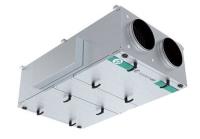 Add My Company
Add My Company
Sign In

The requirement for heat recovery ventilation ( HRV ) has increased substantially over the past two years, due to the COVID-19 pandemic. Increased ventilation is more important than ever, to limit the spread of biological aerosols in indoor environments and reduce the transmission of viruses such as COV-2.
Heat recovery units deliver fresh, filtered air into buildings whilst simultaneously extracting the stagnant air from the interior. Typically located in the roof space of a building, the system draws the heat from the extracted air and combines it with the air that is being filtered in from outside. This warms the fresh air and ensures that it passes into the building at a higher temperature than the outside environment.
The two air currents flow past each other without physically mixing, so there is no risk of contamination of the fresh air by the extracted air. The technology that goes into the development of heat recovery systems has improved quite significantly in recent years, with some systems now able to extract up to 90% of the heat in the used air.
The purpose of this article is to talk you through how and why heat recovery ventilation systems are installed within commercial environments.
Commercial & industrial buildings that require heat recovery
Commercial buildings require adequate ventilation in order to maintain optimal temperatures, control humidity levels and comply with high air quality standards to allow people to breathe in non-polluted air.
Approved Document F (ADF) of the Building Regulations in the UK outlines that new commercial buildings must implement a ventilation system which “under normal conditions, is capable of limiting the accumulation of moisture, which could lead to mould growth, and pollutants originating in a building, which would otherwise become a hazard to the health of people in the building”.
This highlights the need for heat recovery units in many commercial buildings, particularly older buildings that weren’t initially designed with ventilation in mind and therefore risk offering poor indoor air quality. Similarly, increased insulation in newer commercial buildings can significantly heighten the risk of overheating without adequate ventilation.
In both cases, the recovery of heat is crucial to provide cost-efficient and energy-efficient heating and cooling throughout the space. This can be applicable to a number of spaces that serve the general public or provide a place of work, including:
Commercial offices
Industrial plants
Manufacturing premises
Schools
Hospitals
Leisure facilities
Theatres/arenas
The demand for energy-efficient heat recovery is ever increasing across industries. Businesses are quickly becoming aware of the benefits these units provide in regards to recovering wasted heat from their processes and reducing their energy consumption, whilst creating a comfortable environment as a result.
Types of commercial heat recovery
In order to provide heat recovery, commercial air handling units (AHU) are equipped with heat exchangers. The different types of heat exchangers can be divided into rotary heat recovery and crossflow heat recovery.
Rotary heat exchangers
The design of a rotary heat exchanger consists of a series of small aluminium ducts and a rotating wheel. When warm air enters the AHU, it heats the ducts which transfer the heat to the cold air supply. They can typically sustain a high temperature efficiency of up to around 85%.
For more information on The importance of commercial heat recovery ventilation talk to Puravent
Enquire Now
List your company on FindTheNeedle.

